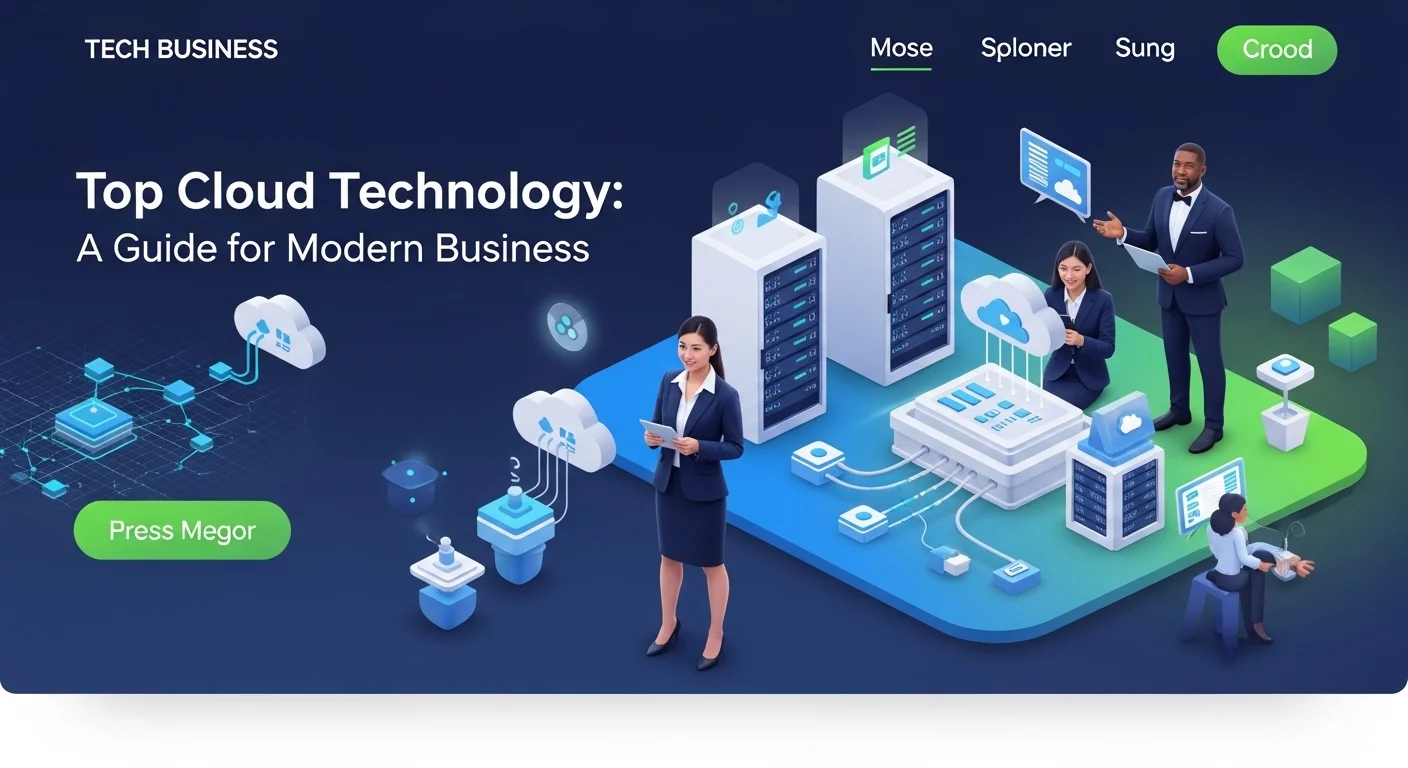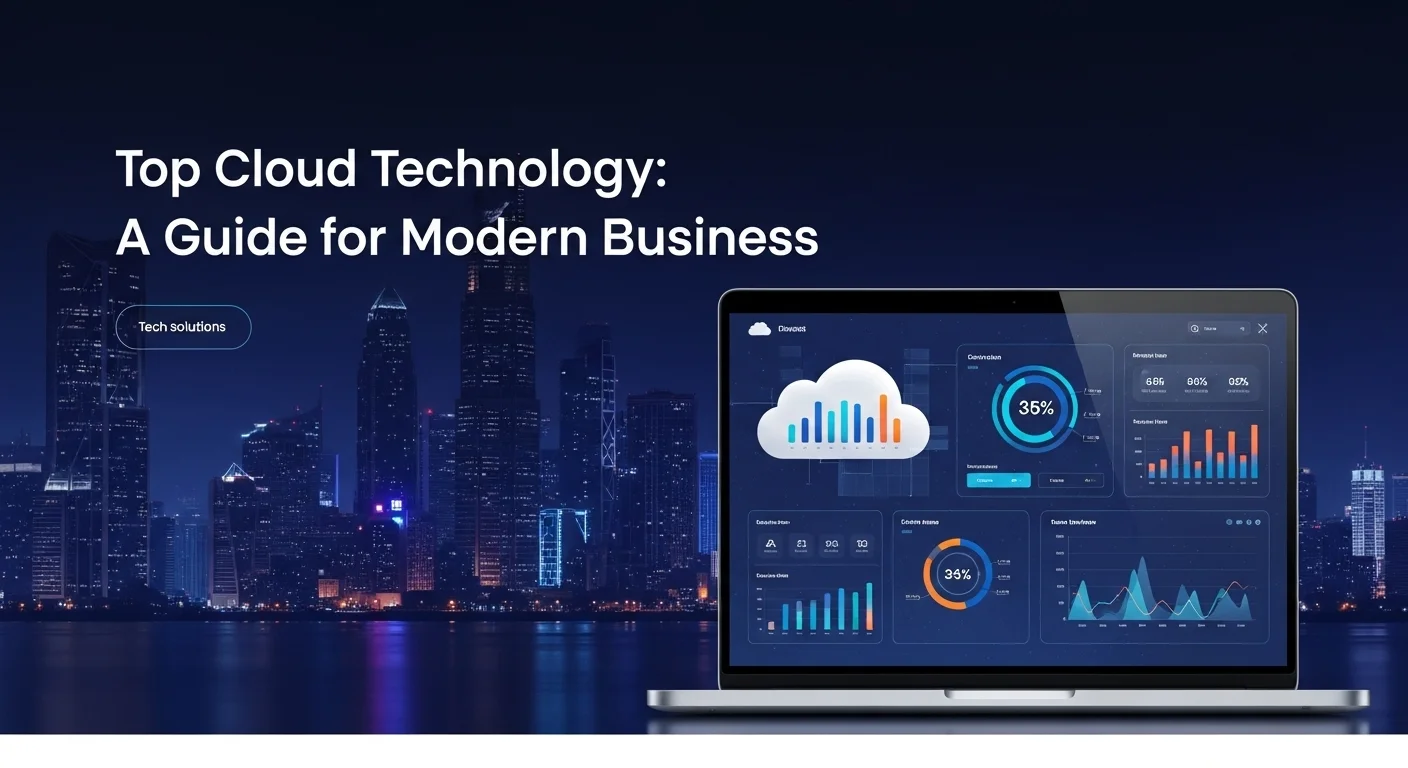Cloud Computing Explained: A Simple Guide for Your Business

Executive Summary
In my years helping businesses find their footing online, I've seen one thing become crystal clear: using the cloud isn't just an option anymore, it's essential for survival and growth. But what does 'the cloud' even mean for you? It can feel like a world of confusing jargon. This guide is here to cut through the noise. We'll walk you through the basics in simple terms, compare the biggest players like AWS and Azure, and help you figure out exactly what your business needs to thrive in today's digital world. Whether you're just starting out or looking to improve what you already have, think of this as your friendly roadmap to making smart tech decisions.
Table of Contents
Table of Contents
What is Cloud Computing and Why Does It Matter?
Let's clear things up. When we talk about 'the cloud,' we're not talking about a single product. We're talking about a massive, global network of servers and the services they provide over the internet. Think of it this way: instead of buying and maintaining your own expensive computer servers in a back room, you rent computing power from a specialized company. This simple idea has completely changed the game. It gives anyone, from a solo entrepreneur in a garage to a massive corporation, access to the same powerful technology. For years, I've seen firsthand how this levels the playing field. A startup can suddenly scale up to serve millions of customers overnight without ever buying a single piece of hardware. This agility is the real magic of the cloud. It frees you up to focus on what you do best—running your business—instead of worrying about managing complex IT infrastructure.
The Fundamental Service Models: IaaS, PaaS, and SaaS
To really get a handle on the cloud, you need to understand the three main ways it's offered. I like to think of them as different levels of 'do-it-yourself.' Each one serves a different need.
Infrastructure as a Service (IaaS): This is the most foundational level. It's like renting a plot of land and the basic utilities. The cloud provider gives you the servers, storage, and networking, but you're in charge of everything else—the operating system, the software, the data. You have total control and flexibility. I've worked with companies that use IaaS for complex, custom projects or when they need to test something without a long-term commitment. Leading providers here are Amazon Web Services (AWS), Google Cloud, and Microsoft Azure. They offer the raw building blocks for your digital projects.
Platform as a Service (PaaS): If IaaS is renting land, PaaS is like renting a fully equipped workshop. You get the servers and storage, but you also get the operating system, development tools, and database management systems. It’s designed for developers. It gives them a platform to build, test, and run their applications without getting bogged down in the underlying infrastructure. From my experience, teams that use PaaS can develop and launch new products much, much faster. Services like Google App Engine or Microsoft Azure App Services are popular choices for development teams wanting to accelerate their workflow.
Software as a Service (SaaS): This is the model you're probably most familiar with, even if you don't realize it. SaaS is like renting a fully furnished apartment—you just move in and start living. The software is delivered over the internet on a subscription basis. You don't install anything, you don't maintain anything; you just use it. Think Google Workspace, Salesforce, or Dropbox. These ready-to-use solutions have become the backbone of modern business operations, providing powerful tools without any of the IT headaches.
Deployment Models: Public, Private, and Hybrid Clouds
Once you understand the service models, the next question is where your cloud lives. This decision often comes down to balancing cost, security, and control.
Public Cloud: This is the most common model. It’s when you use services from a provider like AWS, Google Cloud, or Microsoft Azure. You share the overall infrastructure with other companies, or 'tenants.' It’s like living in a massive, secure apartment complex. The biggest benefits are the low cost (thanks to huge economies of scale), incredible reliability, and the ability to scale up or down almost instantly. For most businesses, this is the most practical and cost-effective starting point.
Private Cloud: A private cloud is a cloud environment dedicated entirely to your organization. It's your own private house. It can be located in your own data center or hosted by a third-party provider, but the key is that none of the resources are shared. I've seen this model chosen by organizations with very strict security or regulatory needs, like banks or hospitals. They need total control over their data and environment. It offers the benefits of cloud architecture but with an added layer of privacy and control.
Hybrid Cloud: As the name suggests, a hybrid cloud is a mix of both. It's the 'best of both worlds' approach that has become incredibly popular. It’s like owning your own house (private cloud) for your most important things, but also renting a flexible storage unit (public cloud) for everything else. For example, a business might keep sensitive customer data on its private cloud but use the public cloud to host its public-facing website. The challenge is making them work together seamlessly, but when done right, it offers unmatched flexibility and efficiency.

Comparing the Best Cloud Platforms for Your Business
Choosing a cloud provider is a major decision. It’s not just about technology; it’s about finding a partner for your business's future. While there are many players, the conversation almost always starts with the 'big three': AWS, Microsoft Azure, and Google Cloud Platform (GCP). I've worked with all of them, and each has its own personality and strengths.
The Titans of the Cloud: AWS vs. Azure vs. GCP
Amazon Web Services (AWS): AWS is the veteran in the room. They were the first to market on a large scale and have the most extensive list of services by a long shot. If there's a niche tech solution you need, chances are AWS has a service for it. Their maturity means they are incredibly reliable and have a huge community of developers and experts. For many, AWS is the go-to choice. The only catch, in my experience, is their pricing can be complex. It’s powerful, but you need to keep a close eye on your bill to avoid surprises.
Microsoft Azure: Azure is Microsoft's powerhouse, and its biggest advantage is its home-turf advantage with businesses that already use Microsoft products. If your company runs on Windows Server, Office 365, and Active Directory, moving to Azure feels like a natural extension. It’s incredibly well-integrated. I've found they are particularly strong in the hybrid cloud space, making it easy to blend your on-site servers with their public cloud. This focus makes them a top choice for established enterprises looking to modernize without starting from scratch.
Google Cloud Platform (GCP): While newer to the race, GCP is a beast when it comes to data. They've built their cloud on the same infrastructure that powers Google Search and YouTube. Their expertise in data analytics, machine learning, and networking is second to none. I often recommend GCP to clients whose business revolves around handling massive datasets or building cutting-edge AI features. They are also known for more customer-friendly pricing and a high-performance network. They might not have as many services as AWS, but what they do, they do exceptionally well.
Beyond the Public Sphere: Private and Hybrid Options
For many large companies, the answer isn't just one public cloud. It’s often a mix. A private cloud gives you ultimate control, which is non-negotiable for industries like finance or healthcare. You can build one yourself using software like OpenStack or VMware, or you can work with vendors like Dell and HPE who offer on-site infrastructure that works like a cloud service.
But the real trend I'm seeing everywhere is a move towards hybrid and multicloud strategies. Hybrid means blending public and private clouds. Multicloud means using services from more than one public provider—say, AWS for general computing and GCP for a specific AI project. The goal is to use the best tool for every job and avoid being locked into a single vendor. This creates management challenges, but new tools like Google Anthos, Azure Arc, and AWS Outposts are emerging to provide a single dashboard to manage everything, making these sophisticated strategies more accessible than ever.
How to Choose Your Cloud Platform: A Strategic Framework
So, how do you choose? It’s a big decision, so don't just look at the tech specs. I always walk my clients through these key questions:
- What are you running? Look at your applications. Are they old-school systems that need a basic server (IaaS), or are they modern apps ready for a development platform (PaaS)? Your workload dictates the best starting point.
- What are your rules? Do you have strict compliance or data residency requirements? Your security needs will heavily influence whether you lean towards a public, private, or hybrid model.
- Who is on your team? Do your people already know AWS? Are they Microsoft experts? Leaning into your team's existing skills can save you a lot of time and training costs.
- What's the real cost? Don't just look at the price per server. Consider the total cost, including data transfer fees (a common 'gotcha'!), management time, and potential savings from long-term commitments.
- Where are you going? Choose a partner that can grow with you. Look at their investments in innovation and their ability to support future technologies you might need, like IoT or advanced AI.
Thinking through these points will help you choose a platform that doesn't just work for you today but empowers your growth for years to come.

Practical Tips for Using the Cloud Effectively
Moving to the cloud is one thing; using it well is another. Over the years, I've seen companies thrive and struggle based on their approach. To get the most out of your investment, you need a smart strategy. Here are some of the most important tips and practices I share with every client.
Mastering the Cloud: Best Practices for Success
1. Adopt a 'Cloud-First,' Not 'Cloud-Only' Mindset: A 'cloud-first' approach means you always consider a cloud solution before anything else for new projects. This encourages modern thinking. However, it's a mistake to think everything *must* go to the cloud. Some old systems or specialized equipment are better left on-site. The smartest companies I've worked with use a hybrid approach, choosing the right environment for each specific job.
2. Understand That Security Is a Partnership: This is the most critical concept to grasp. Your cloud provider (like AWS or Azure) is responsible for the security *of* the cloud—the physical data centers and hardware. But you are responsible for security *in* the cloud. That means you have to configure your firewalls, manage who has access to what, and encrypt your data. A huge number of data breaches happen simply because customers misconfigure their settings. It's a team effort.
3. Get a Handle on Your Spending with FinOps: Cloud bills can be a shock if you're not paying attention. FinOps is a practice that brings financial discipline to your cloud spending. This means tagging every resource so you know which department or project is spending what, using cost-monitoring tools to watch your spending in real-time, and actively optimizing by shutting down unused servers or committing to savings plans for predictable workloads. Without this, costs can easily spiral.
4. Automate Everything You Can: The cloud is too dynamic for manual management. Embrace automation through practices like Infrastructure as Code (IaC) with tools like Terraform. This allows you to define your entire IT setup in a code file, making it repeatable, consistent, and easy to audit. Automating your deployment pipelines also lets you release new app features faster and more reliably—one of the key promises of the cloud.
Leveraging Advanced Cloud Services and Tools
The real power of the cloud emerges when you go beyond the basics. These advanced services can give you a serious competitive edge.
Serverless Computing: This is a game-changer. With services like AWS Lambda or Azure Functions, you can run code without thinking about servers at all. You just upload your code, and the cloud runs it for you, charging you only for the fractions of a second it's active. It's perfect for tasks with unpredictable traffic and is an incredibly cost-effective way to build modern applications.
Containers and Kubernetes: Containers (like Docker) bundle up an application and all its dependencies into one neat package. Kubernetes is the tool everyone uses to manage these containers at scale. All the major cloud providers offer managed Kubernetes services that take the headache out of running complex, modern applications. If you're building for the future, you should be looking at containers.
AI and Machine Learning Services: The cloud has made AI accessible to everyone. Providers offer powerful tools like Amazon SageMaker and Google's AI Platform that let you build, train, and deploy sophisticated machine learning models. You can add smart features to your apps, analyze customer behavior, or make predictions, all without needing a dedicated team of AI researchers.
Staying Ahead: Future Trends and Key Resources
The cloud never stands still. Keeping an eye on the horizon is key to making sure your strategy doesn't become outdated.
Edge Computing: As more devices connect to the internet (IoT), it makes more sense to process data closer to the device—at the 'edge'—instead of sending it all to the cloud. This reduces delays and is essential for things like self-driving cars or smart factories. Cloud providers are already extending their platforms to the edge.
'Green' Cloud: Data centers use a tremendous amount of energy. Sustainability is now a major focus. The leading providers are investing heavily in renewable energy and giving customers tools to track the carbon footprint of their services. For many companies, choosing a green provider is becoming an important part of their corporate responsibility.
Quality External Resources: To make informed decisions, you need trusted data. For a deep dive into how different providers stack up, I always recommend the Gartner Magic Quadrant for Cloud Infrastructure and Platform Services. It's a highly respected report that provides detailed, unbiased analysis and is a go-to resource for enterprise leaders making these big decisions.
By putting these strategies into practice, your business can turn the cloud from a simple utility into your most powerful engine for innovation and growth.
Expert Reviews & Testimonials
Sarah Johnson, Business Owner ⭐⭐⭐⭐
As a small business owner, this was a great starting point. I finally get the difference between IaaS and SaaS! I would have loved a section on budgeting for a small company, but overall it was very helpful.
Mike Chen, IT Consultant ⭐⭐⭐⭐⭐
Solid overview. As an IT consultant, I often have to explain these concepts to clients. The analogies used here are perfect for that. I'll be sharing this with my team.
Emma Davis, Tech Expert ⭐⭐⭐⭐⭐
Fantastic and thorough article. It connected all the dots for me, especially the part about hybrid cloud strategies. It's rare to find a guide that's both comprehensive for experts and clear for newcomers. Well done.



